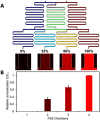A high-throughput integrated biofilm-on-a-chip platform for the investigation of combinatory physicochemical responses to chemical and fluid shear stress
- PMID: 35960726
- PMCID: PMC9374262
- DOI: 10.1371/journal.pone.0272294
A high-throughput integrated biofilm-on-a-chip platform for the investigation of combinatory physicochemical responses to chemical and fluid shear stress
Abstract
Physicochemical conditions play a key role in the development of biofilm removal strategies. This study presents an integrated, double-layer, high-throughput microfluidic chip for real-time screening of the combined effect of antibiotic concentration and fluid shear stress (FSS) on biofilms. Biofilms of Escherichia coli LF82 and Pseudomonas aeruginosa were tested against gentamicin and streptomycin to examine the time dependent effects of concentration and FSS on the integrity of the biofilm. A MatLab image analysis method was developed to measure the bacterial surface coverage and total fluorescent intensity of the biofilms before and after each treatment. The chip consists of two layers. The top layer contains the concentration gradient generator (CGG) capable of diluting the input drug linearly into four concentrations. The bottom layer contains four expanding FSS chambers imposing three different FSSs on cultured biofilms. As a result, 12 combinatorial states of concentration and FSS can be investigated on the biofilm simultaneously. Our proof-of-concept study revealed that the reduction of E. coli biofilms was directly dependent upon both antibacterial dose and shear intensity, whereas the P. aeruginosa biofilms were not impacted as significantly. This confirmed that the effectiveness of biofilm removal is dependent on bacterial species and the environment. Our experimental system could be used to investigate the physicochemical responses of other biofilms or to assess the effectiveness of biofilm removal methods.
Conflict of interest statement
The authors have declared that no competing interests exist.
Figures




Similar articles
-
Multichannel Microfluidic Platform for Temporal-Spatial Investigation of Niche Roles of Pseudomonas aeruginosa and Escherichia coli within a Dual-Species Biofilm.Appl Environ Microbiol. 2023 Jul 26;89(7):e0065123. doi: 10.1128/aem.00651-23. Epub 2023 Jun 29. Appl Environ Microbiol. 2023. PMID: 37382537 Free PMC article.
-
Ultrasonic-enhanced gentamicin transport through colony biofilms of Pseudomonas aeruginosa and Escherichia coli.J Infect Chemother. 2004 Aug;10(4):193-9. doi: 10.1007/s10156-004-0319-1. J Infect Chemother. 2004. PMID: 15365858 Free PMC article.
-
Understanding the effects of aerodynamic and hydrodynamic shear forces on Pseudomonas aeruginosa biofilm growth.Biotechnol Bioeng. 2022 Jun;119(6):1483-1497. doi: 10.1002/bit.28077. Epub 2022 Mar 21. Biotechnol Bioeng. 2022. PMID: 35274289 Free PMC article.
-
Image-based 384-well high-throughput screening method for the discovery of skyllamycins A to C as biofilm inhibitors and inducers of biofilm detachment in Pseudomonas aeruginosa.Antimicrob Agents Chemother. 2014;58(2):1092-9. doi: 10.1128/AAC.01781-13. Epub 2013 Dec 2. Antimicrob Agents Chemother. 2014. PMID: 24295976 Free PMC article.
-
Autoinducer-2 analogs and electric fields - an antibiotic-free bacterial biofilm combination treatment.Biomed Microdevices. 2016 Oct;18(5):95. doi: 10.1007/s10544-016-0120-9. Biomed Microdevices. 2016. PMID: 27647148
Cited by
-
A simulated microgravity biofilm reactor with integrated microfabricated sensors: Advancing biofilm studies in near-space conditions.Biofilm. 2025 Feb 17;9:100263. doi: 10.1016/j.bioflm.2025.100263. eCollection 2025 Jun. Biofilm. 2025. PMID: 40083859 Free PMC article.
-
Influence of Hydrodynamic Forces on Electroactive Bacterial Adhesion in Microbial Fuel Cell Anodes.Bioengineering (Basel). 2023 Nov 30;10(12):1380. doi: 10.3390/bioengineering10121380. Bioengineering (Basel). 2023. PMID: 38135971 Free PMC article.
References
-
- Park A, Jeong H-H, Lee J, Kim KP, Lee C-S. Effect of shear stress on the formation of bacterial biofilm in a microfluidic channel. BioChip Journal. 2011;5: 236–241.
Publication types
MeSH terms
Substances
LinkOut - more resources
Full Text Sources
Research Materials

